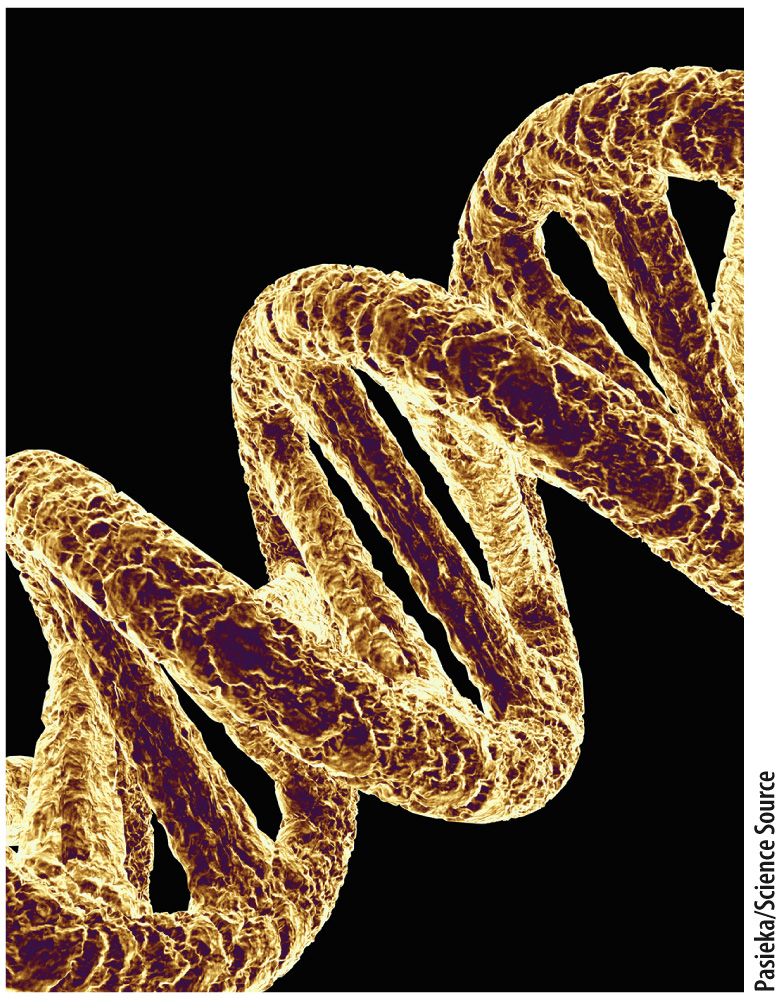Chapter 3 Introduction
Nucleic Acids and Transcription

Pasieka/Science Source.
Core Concepts
- Deoxyribonucleic acid (DNA) stores and transmits genetic information.
- DNA is a polymer of nucleotides and forms a double helix.
- Transcription is the process by which RNA is synthesized from a DNA template.
- The primary transcript is processed to become messenger RNA (mRNA).
So much in biology depends on shape. Take your hand, for example. You can pick up a pin, text on a smartphone, or touch your pinky to your thumb. These activities are made possible by the coordinated movement of dozens of bones, muscles, nerves, and blood vessels that give shape to your hand. The functional abilities of your hand emerge from its structure. A causal connection between structure and function exists in many molecules, too. Proteins are a good example. Composed of long, linear strings of 20 different kinds of amino acids in various combinations, each protein folds into a specific three-dimensional shape due to chemical interactions between the amino acids along the chain. The three-dimensional structure of the protein determines its functional properties, such as what other molecules it can bind with, and enables the protein to carry out its job in the cell.
Another notable example is the macromolecule deoxyribonucleic acid (DNA), a linear polymer of four different subunits. DNA molecules from all cells and organisms have a very similar three-dimensional structure, reflecting their shared ancestry. This structure, called a double helix, is composed of two strands coiled around each other to form a sort of spiral staircase. The banisters of the spiral staircase are formed by the linear backbone of the paired strands, and the steps are formed by the pairing of the subunits at the same level in each strand.
The spiral-staircase structure is common to all cellular DNA molecules, and its structure gave immediate clues to its function. First, DNA stores information. Some of the information in DNA encodes for proteins that provide structure and do much of the work of the cell. Information in DNA is called genetic information, and it is organized in the form of genes, as textual information is organized in the form of words. Genes can exist in different forms in different individuals, even within a single species. Differences in genes can affect the shape of the hand, for example, yielding long or short fingers or extra or missing fingers. As we will see, it is the order of individual subunits (bases) of DNA that accounts for differences in genes. Genes usually have no effect on the organism unless they are “turned on” and their product is made. The turning on of a gene is called gene expression. The molecular processes that control whether gene expression occurs at a given time or in a given cell constitute gene regulation.
Second, DNA transmits genetic information from one generation to the next. The transmission of genetic information from parents to their offspring enables species of organisms to maintain their identity through time. The genetic information in DNA guides the development of the offspring, ensuring that parental apple trees give rise to apple seedlings and parental geese give rise to goslings. As we will see, determining the double-helical structure of DNA provided one of the first hints of how genetic information could be faithfully copied from cell to cell, and from one generation to the next.
In this chapter, we examine the structure of DNA in more detail and show how its structure is well suited to its biological function as the carrier and transmitter of genetic information.
